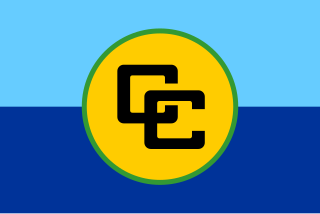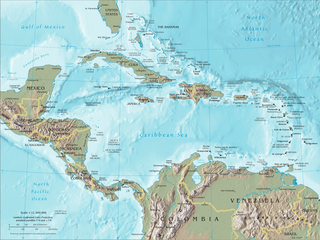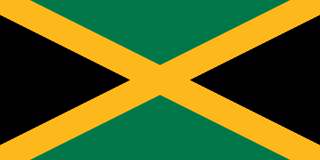Timeline
Notes
- ↑ See also Territorial evolution of California.
- ↑ ’Unorganised territory’ was not an official name, rather it referred to any United States territory without an official name.
- ↑ Colorado at this point in time was split between the Kansas Territory, Utah Territory, Nebraska Territory and the New Mexico Territory, with the majority being within the Kansas Territory.
Related Research Articles

The Caribbean Community is an intergovernmental organisation that is a political and economic union of 15 member states and five associated members throughout the Americas, The Caribbean and Atlantic Ocean. It has the primary objective to promote economic integration and cooperation among its members, ensure that the benefits of integration are equitably shared, and coordinate foreign policy. The organisation was established in 1973, by its four founding members signing the Treaty of Chaguaramas. Its primary activities involve:

The British West Indies (BWI) were colonised British territories in the West Indies: Anguilla, the Cayman Islands, Turks and Caicos Islands, Montserrat, the British Virgin Islands, Antigua and Barbuda, The Bahamas, Barbados, Dominica, Grenada, Jamaica, Saint Kitts and Nevis, Saint Lucia, Saint Vincent and the Grenadines, British Honduras, British Guiana and Trinidad and Tobago. Bermuda was also included as one of the territories.
This gallery of sovereign state flags shows the national or state flags of sovereign states that appear on the list of sovereign states. For flags of other entities, please see gallery of flags of dependent territories. Each flag is depicted as if the flagpole is positioned on the left of the flag, except for those of Iran, Iraq and Saudi Arabia which are depicted with the hoist to the right.

The Commonwealth Caribbean is the region of the Caribbean with English-speaking countries and territories, which once constituted the Caribbean portion of the British Empire and are now part of the Commonwealth of Nations. The term includes many independent island nations, British Overseas Territories and some mainland nations.
The Caribbean Examinations Council (CXC) is an examination board in the Caribbean. It was established in 1972 under agreement by the participating governments in the Caribbean Community to conduct such examinations as it may think appropriate and award certificates and diplomas on the results of any such examinations so conducted. The council is empowered to regulate the conduct of any such examinations and prescribe the qualification requirements of candidates and the fees payable by them. It is now an examining body that provides educational certifications in 16 English-speaking Commonwealth Caribbean countries and territories and has replaced the General Certificate of Education (GCE) examinations used by England and some other members of the Commonwealth. The CXC is an institution of the Caribbean Community (CARICOM); it was recognised as an Associate Institution of the Community in the 1973 treaty that created the Caribbean Community. Members of the council are drawn from the 16 territories and the region's two universities, the University of Guyana and the University of the West Indies.

The CARICOM Single Market and Economy, also known as the Caribbean Single Market and Economy (CSME), is an integrated development strategy envisioned at the 10th Meeting of the Conference of Heads of Government of the Caribbean Community (CARICOM) which took place in July 1989 in Grand Anse, Grenada. The Grand Anse Declaration had three key Features:
- Deepening economic integration by advancing beyond a common market towards a Single Market and Economy.
- Widening the membership and thereby expanding the economic mass of the Caribbean Community.
- Progressive insertion of the region into the global trading and economic system by strengthening trading links with non-traditional partners.

The West Indies is a subregion of North America, surrounded by the North Atlantic Ocean and the Caribbean Sea, which comprises 13 independent island countries and 19 dependencies in three archipelagos: the Greater Antilles, the Lesser Antilles, and the Lucayan Archipelago.

The Caribbean Free Trade Association (CARIFTA) was an English-speaking economic trade organisation. It organised on 1 May 1968, to provide a continued economic linkage between the English-speaking countries of the Caribbean. The agreements establishing it came following the dissolution of the West Indies Federation, which lasted from 1958 to 1962.

The CARICOM passport is a passport document issued by the 15 member states of the Caribbean Community (CARICOM) for their citizens. It can be used both for intra-regional and international travel. The passport was created to facilitate intra-region travel; however, citizens of the OECS that are citizens from Antigua and Barbuda, Dominica, Grenada, St. Kitts and Nevis, Saint Lucia, Guyana and St. Vincent and the Grenadines may use a member-state issued drivers licence, national identification card, voters registration card or social security card for travel within the OECS area.

Antigua and Barbuda maintains diplomatic relations with the United States, Canada, the United Kingdom, and the People's Republic of China, as well as with many Latin American countries and neighbouring Eastern Caribbean states. It is a member of the United Nations, the Commonwealth of Nations, the Organization of American States, the Organisation of Eastern Caribbean States, the Bolivarian Alliance for the Americas, Petrocaribe and the Eastern Caribbean's Regional Security System (RSS).

The Caribbean is a subregion of the Americas that includes the Caribbean Sea and its islands, some of which are surrounded by the Caribbean Sea and some of which border both the Caribbean Sea and the North Atlantic Ocean; the nearby coastal areas on the mainland are sometimes also included in the region. The region is south-east of the Gulf of Mexico and Northern America, east of Central America, and north of South America.
The nation of Barbados has been a supporter of the Caribbean Community (CARICOM). Barbados was one of the four founding members in 1973 which then along with Guyana, Jamaica, and Trinidad and Tobago moved to establish the organization then known as the Caribbean Community and Common Market. This new organization became a successor to the Caribbean Free Trade Association (CARIFTA) of which Barbados was also a member.

There are 12 monarchies in the Americas, being either sovereign states or self-governing territories that have a monarch as head of state. Each is a constitutional monarchy, wherein the monarch inherits his or her office according to law, usually keeping it until death or abdication, and is bound by laws and customs in the exercise of their powers. Ten of these monarchies are part of the global personal union known as the Commonwealth realms and share Charles III, who resides in the United Kingdom, as king. The other two are the Monarchy of the Netherlands which is used in states of the Dutch Caribbean, and the Monarchy of Denmark which is used in Greenland. As such, none of the monarchies in the Americas have a permanently residing monarch, though the Commonwealth realms each have a resident governor-general to represent King Charles III and perform most of his constitutional duties in his name; and a high commissioner represents the King of Denmark and the Danish government in Greenland. Additionally, each of Canada's 10 provinces functions as a subnational constituent monarchy, with the constitutional powers vested in the King exercised at the provincial level by a lieutenant governor.

This is a timeline of the territorial evolution of the Caribbean and nearby areas of North, Central, and South America, listing each change to the internal and external borders of the various countries that make up the region.

Jamaicans are the citizens of Jamaica and their descendants in the Jamaican diaspora. The vast majority of Jamaicans are of Sub-Saharan African descent, with minorities of Europeans, Indians, Chinese, Middle Eastern, and others of mixed ancestry. The bulk of the Jamaican diaspora resides in other Anglophone countries, namely Canada, the United States and the United Kingdom. Jamaican populations are also prominent in other Caribbean countries, territories and Commonwealth realms, where in the Cayman Islands, born Jamaicans, as well as Caymanians of Jamaican origin, make up 26.8% of the population. Outside of Anglophone countries, the largest Jamaican diaspora community lives in Central America, where Jamaicans make up a significant percentage of the population.
The Methodist Church in the Caribbean and Americas is a Methodist denomination in Anguilla, Antigua and Barbuda, Aruba, the Bahamas, Barbados, Belize, Bonaire, the British & the US Virgin Islands, the Cayman Islands, Costa Rica, Curaçao, Dominica, Grenada, Guyana, Haiti, Honduras, Jamaica, Panama, Saint Kitts and Nevis, Saint Lucia, Saint Martin, Saint Vincent and the Grenadines, Sint Eustatius, Trinidad and Tobago, and the Turks and Caicos Islands. The Connexion is divided into eight districts:
The following lists events that happened during 2021 in the Caribbean.
The following lists events that happened during 2022 in the Caribbean.
References
- 1 2 3 4 5 6 7 "Antigua and Barbuda". WORLD STATESMEN.org. Retrieved 21 January 2017.
- 1 2 "The West Indies Federation". CARICOM. Retrieved 8 January 2017.
- ↑ "Antigua and Barbuda". CARICOM. Retrieved 8 January 2017.
- ↑ "Our History". The Islands Of The Bahamas. Retrieved 8 January 2017.
- 1 2 3 "Bahamas". WORLD STATESMEN.org. Retrieved 21 January 2017.
- 1 2 3 4 "Barbados". WORLD STATESMEN.org. Retrieved 21 January 2017.
- 1 2 3 4 "Belize". WORLD STATESMEN.org. Retrieved 21 January 2017.
- 1 2 "Belize profile - Timeline". BBC News. BCC. 1 November 2015. Retrieved 16 December 2016.
- ↑ "British Columbia Timeline". worldatlas.com. Retrieved 10 January 2017.
- 1 2 3 Brendan Anthony O'Grady; Barry Moody (26 November 2013). "Nova Scotia". Encyclopædia Britannica. Encyclopædia Britannica, inc. Retrieved 10 January 2017.
- ↑ "New Brunswick History". Government of New Brunswick. 18 May 2010. Retrieved 10 January 2017.
- 1 2 3 4 5 "Island Information: Historical Milestones". Prince Edward Island. Government of Prince Edward Island. Retrieved 10 January 2017.
- ↑ Horváth, Zoltán (12 August 2013). "Central America - Historical Unions and Federations". Flags Of The World. Retrieved 10 January 2017.
- 1 2 "Haiti profile - Timeline". BBC News. BBC. 12 October 2016. Retrieved 16 December 2016.
- 1 2 "Haiti". World Statesmen.org. Retrieved 21 January 2017.
- 1 2 3 4 "Jamaica". WORLD STATESMEN.org. Retrieved 21 January 2017.
- 1 2 3 "Mexico". WORLD STATESMEN.org. Retrieved 21 January 2017.
- 1 2 3 4 5 6 7 8 9 "Saint kitts and Nevis". WORLD STATESMEN.org. Retrieved 21 January 2017.
- ↑ "St Lucia country profile". BBC News. BBC. 7 June 2016. Retrieved 16 December 2016.
- 1 2 3 4 5 Ramerini, Marco (13 January 2014). "Dutch and Courlanders on Tobago. A history of the first settlements 1628-1677". Colonial Voyage. Retrieved 21 January 2017.
- 1 2 3 4 "Timeline of Alaska's History". Alaska Public Lands Information Centers. Retrieved 27 June 2016.
- ↑ "BRIEF HISTORY OF MONTANA". montana.gov. Retrieved 12 January 2017.
- ↑ "A Brief History of the Danish West Indies, 1666-1917". Virgin Islands history. Danish National Archives. Retrieved 27 June 2016.